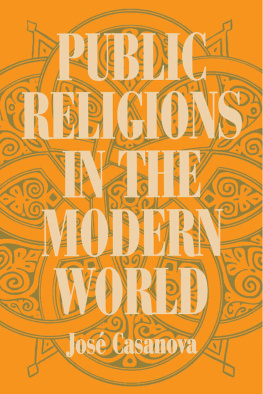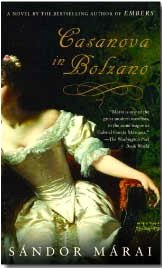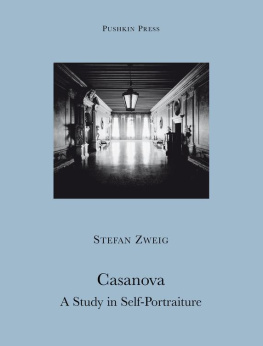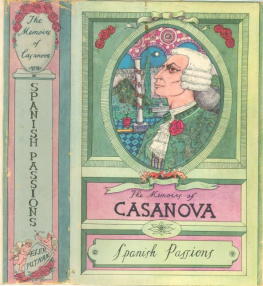José Casanova - Public Religions in the Modern World (Conference Report)
Here you can read online José Casanova - Public Religions in the Modern World (Conference Report) full text of the book (entire story) in english for free. Download pdf and epub, get meaning, cover and reviews about this ebook. year: 2011, publisher: University of Chicago Press, genre: Religion. Description of the work, (preface) as well as reviews are available. Best literature library LitArk.com created for fans of good reading and offers a wide selection of genres:
Romance novel
Science fiction
Adventure
Detective
Science
History
Home and family
Prose
Art
Politics
Computer
Non-fiction
Religion
Business
Children
Humor
Choose a favorite category and find really read worthwhile books. Enjoy immersion in the world of imagination, feel the emotions of the characters or learn something new for yourself, make an fascinating discovery.
- Book:Public Religions in the Modern World (Conference Report)
- Author:
- Publisher:University of Chicago Press
- Genre:
- Year:2011
- Rating:5 / 5
- Favourites:Add to favourites
- Your mark:
- 100
- 1
- 2
- 3
- 4
- 5
Public Religions in the Modern World (Conference Report): summary, description and annotation
We offer to read an annotation, description, summary or preface (depends on what the author of the book "Public Religions in the Modern World (Conference Report)" wrote himself). If you haven't found the necessary information about the book — write in the comments, we will try to find it.
Public Religions in the Modern World (Conference Report) — read online for free the complete book (whole text) full work
Below is the text of the book, divided by pages. System saving the place of the last page read, allows you to conveniently read the book "Public Religions in the Modern World (Conference Report)" online for free, without having to search again every time where you left off. Put a bookmark, and you can go to the page where you finished reading at any time.
Font size:
Interval:
Bookmark:
The University of Chicago Press, Chicago 60637
The University of Chicago Press, Ltd., London
1994 by The University of Chicago
All rights reserved. Published 1994
Printed in the United States of America
13 12 11 10 7 8
ISBN: 978-0-226-19020-4 (e-book)
ISBN: 0-226-09535-5 (paper)
Library of Congress Cataloging-in-Publication Data
Casanova, Jos
Public religions in the modern world / Jos Casanova.
p. cm.
Includes bibliographical references and index.
1. Religion and sociology. I. Title.
BL60.C375 1994
306.6dc20
[322.43'3'0882]
93-37485
CIP
 The paper used in this publication meets the minimum requirements of the American National Standard for Information SciencesPermanence of Paper for Printed Library Materials, ANSIZ39.48-1992.
The paper used in this publication meets the minimum requirements of the American National Standard for Information SciencesPermanence of Paper for Printed Library Materials, ANSIZ39.48-1992.
Jos Casanova
Public Religions in the Modern World
The University of Chicago Press
Chicago and London
For Ika and Olexa
Contents
Acknowledgments
A study on the relevance of traditions to the vitality of the modern public sphere can hardly skirt the tradition of acknowledging its many debts, even though I feel for this tradition the same ambivalence I feel for all religious traditions. My deepest debts are private, and here I would like to respect sacredly those boundaries between the private and the public spheres which are so crucial to sustaining and protecting both of them.
Through the years Ive learned from many teachers. Two in particular formed my thinking on religion. A theologian at the University of Innsbruck, Franz Schupp, one of the first victims of the postVatican II purges, taught me that critical theory can be a form of religious practice. A comparative historical sociologist, Benjamin Nelson, taught me the limits which the sociological reality principle sets to critical theory. Two others, Arthur Vidich and Stanford Lyman, aided in my sociological education and offered support at critical junctures.
The project for this book first originated in the public sphere of Telos. My intellectual development owes much to this experience, particularly to the friendship of and conversation with Paul Piccone, Juan Corradi, and, above all, Andrew Arato, Seyla Benhabib, Jean Cohen, and Joel Whitebook, who took seriously Habermass claim that discourse ethics were relevant both for critical theory and for the public sphere.
In the same way as churches and religious institutions can concentrate on their primary task of caring for the welfare of individual souls, universities and academic institutions can concentrate on their primary task of attaining and transmitting knowledge. When they neglect their duties as public institutions, however, the resulting void affects the life of the spirit, the quality of the knowledge they impart, and the vitality of the public sphere. I was fortunate to find an alma mater and an academic home, the New School for Social Research, which has resisted the trend of academic privatization.
Many friends and colleagues have read drafts of the manuscript. Those whose critical reading, comments, and ongoing conversation helped improve the text were my brother Julin Casanova, Jeffrey Alexander, Said Arjomand, Talal Assad, Josetxo Beriain, Richard Bernstein, Ralph Delia Cava, Mustafa Emirbayer, Robert Fishman, Carlos Forment, Vittorio Hsle, Ira Katznelson, Jnos Kis, Juan Linz, Otto Maduro, Jos Mara Mardones, Martin Marty, Elzbieta Matynia, Martin Riesebrodt, Catalina Romero, Roman Szporluk, Jadwiga Staniszkis, Frank Sysyn, Charles Tilly, Louise Tilly, Edward Tiryakian, Arthur Vidich, Francisco Weffort, Jeff Weintraub, and Alan Wolfe. I am particularly indebted to Andrew Arato for his ideas, his support, and his critical skill through the years. The encouragement and support of Jeffrey Goldfarb also deserve special mention.
Parts of the book were first presented at various conferences, lectures, and seminars at Columbia University, the Center for European Studies at Harvard University, UCLA, the University of Michigan, and the New School for Social Research. I thank those who invited me. Above all, my argument was developed in conversation with numerous students from the Graduate Faculty and Eugene Lang College. Perry Chang, Harry Dahms, Randal Hepner, Susan Pearce, and Amy Siskind have been the longest and most effective conversants. Alas, my dialogue with Carmen Espaillat was interrupted tragically, all too soon.
Finally, I must acknowledge that the task of publishing this book was made much easier, even enjoyable, thanks to the care, guidance, and editorial expertise of Doug Mitchell and Jennie Lightner at the University of Chicago Press.
I
Introduction
Pre-text: Religion in the 1980s
Religion in the 1980s went public in a dual sense. It entered the public sphere and gained, thereby, publicity. Various publicsthe mass media, social scientists, professional politicians, and the public at largesuddenly began to pay attention to religion. The unexpected public interest derived from the fact that religion, leaving its assigned place in the private sphere, had thrust itself into the public arena of moral and political contestation. Above all, four seemingly unrelated yet almost simultaneously unfolding developments gave religion the kind of global publicity which forced a reassessment of its place and role in the modern world. These four developments were the Islamic revolution in Iran; the rise of the Solidarity movement in Poland; the role of Catholicism in the Sandinista revolution and in other political conflicts throughout Latin America; and the public reemergence of Protestant fundamentalism as a force in American politics.
During the entire decade of the 1980s it was hard to find any serious political conflict anywhere in the world that did not show behind it the not-so-hidden hand of religion. In the Middle East, all the religions and fundamentalisms of the regionJewish, Christian, and Muslimfed by old power struggles, were meeting each other in civil and uncivil wars. Old feuds between the various world religions and between branches of the same religions were flaring up again from Northern Ireland to Yugoslavia from India to the Soviet Union. Simultaneously, religious activists and churches were becoming deeply involved in struggles for liberation, justice, and democracy throughout the world. Liberation theologies were spreading beyond Latin America, acquiring new forms and names, African and Asian, Protestant and Jewish, black and feminist. With the collapse of socialism, liberation theology seemed the only International that was left.
The decade, which began in 1979 with the Iranian and Nicaraguan revolutions, the visit of the Polish pope to Poland, and the establishment of the Moral Majority, ended as dramatically and as ambiguously as it had begun, with the Salman Rushdie affair, the death of Ayatollah Khomeini, the final triumph of Solidarity reverberating throughout Eastern Europe, and Gorbachevs visit to the pope. It was symbolically fitting that even the Romanian Revolution was sparked by a Hungarian Reformed pastor. No less telling was the fact that in El Salvador the decade which had opened with the assassination of Archbishop Romero closed with the murder of yet six more Jesuits by state terror.
Throughout the decade religion showed its Janus face, as the carrier not only of exclusive, particularist, and primordial identities but also of inclusive, universalist, and transcending ones. The religious revival signaled simultaneously the rise of fundamentalism and of its role in the resistance of the oppressed and the rise of the powerless. Ali Shariati, the intellectual father of the Islamic revolution, in translating Franz Fanons Les Damns de la Terre, chose the resonant Koranic term
Next pageFont size:
Interval:
Bookmark:
Similar books «Public Religions in the Modern World (Conference Report)»
Look at similar books to Public Religions in the Modern World (Conference Report). We have selected literature similar in name and meaning in the hope of providing readers with more options to find new, interesting, not yet read works.
Discussion, reviews of the book Public Religions in the Modern World (Conference Report) and just readers' own opinions. Leave your comments, write what you think about the work, its meaning or the main characters. Specify what exactly you liked and what you didn't like, and why you think so.











